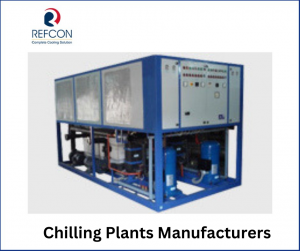
chilling plants
Chilling plants are used in the food industry to maintain the quality of chilled goods.
MUMBAI, MAHARASHTRA, INDIA, December 29, 2022 /EINPresswire.com/ — The chilling plant, a critical piece of equipment that ensures the best quality of products and services, is constantly upgrading in terms of technology and influencing the quality of services. With several chiller manufacturers making systems dynamic and versatile, upgrading the chilling plants and other systems is also improving overall efficiency.
Chilling plants are used in the food industry to maintain the quality of chilled goods. It is an essential component of any cold storage facility and plays a crucial role in maintaining the quality of your products. The chilling process helps maintain the freshness and taste of foods by slowing their metabolism. This also helps retard spoilage pathogens that cause deterioration in food products. The chilling process can be divided into two phases – Air Chilling and Liquid Chilling.
Chilling plants aid with applying low temperatures to plant material for a predetermined period. The purpose of chilling plants is to induce a physiological dormancy state in plants, which can be done after harvesting them or during transport from one location to another. Initially, it was thought that chilling only induces dormancy. Still, it has been found that chilling induces biochemical alterations, which are highly useful for preserving fruit quality and shelf life.
Insights into Chilling Plants and their working dynamics
A chilling plant is used to lower the temperature of the air. It does this by-passing cool water through a series of pipes, which evaporate water from the air and cool it down. The process also removes any heat inside the building or factory to ensure swift working in an area with high humidity.
Chilling plants are often attached to large cooling towers that absorb excess heat from these towers and transfer them into the rest of the facility’s atmosphere via suction fans or pipes connected directly to them. While conventional refrigeration systems rely only on mechanical means such as pumps and fans, chilling plants use physical cooling methods like evaporation/condensation cycles.
Upgrades and technological innovation in chilling plants
Chilling plants have been around since at least the late 1800s when they were first used by railroads to keep their engines from overheating during long train rides or overnight stops on hot summer days.
A chilling plant is a facility that cools water with the help of refrigeration. It cools water, air, food, and other products.
Today, many companies use chilling plants to reduce energy consumption while maintaining temperatures within acceptable ranges for food processing, which means less waste and less pollution.
There are many different chilling plants, each with pros and cons. Here’s a list of some of the most common chiller types:
Brine Chiller
They are used to produce brine at temperatures below -20°C. These Brine chillers are usually used in the food industry or for transporting perishable items such as meat or fish. They can also be found in large-scale cooling centers where they freeze water into ice cubes and then store them while being transported from one place to another through high-pressure pipes called cryogenic lines. The liquid brine produced by this machine contains large amounts of salt, excellent for use in agriculture as it keeps potentially harmful bacteria away from plants during transportation periods when temperatures reach 0 degrees Celsius (-18°F).
Cold Storage Equipment
These machines keep things cold without using any high amount of electricity whatsoever. This makes them perfect tools that help keep businesses running smoothly while ensuring that all their stuff stays fresh enough to avoid spoiled food products within their facilities.
Industrial Dehumidifier
These Industrial Dehumidifier units use cold air to remove moisture from the air in an enclosed space by condensing it onto a surface where evaporation occurs at low temperatures. They can be used in warehouses or other buildings where large quantities of water need to be removed from the air before they cause damage or become hazardous due to mold growth.
Several different types of chilling plants can be used for refrigeration systems. These include industrial dehumidifiers, brine chillers, and cold storage facilities. The choice between these options depends on the needs and the type of system required. Chiller manufacturers put consistent efforts into upgrading the technology for better and enhanced efficiency. Thus, Chilling plants are emerging as a great way to keep food fresh and safe for established businesses.
About REFCON TECHNOLOGIES AND SYSTEMS PVT. LTD,
As one of India’s most reliable chiller manufacturers, REFCON TECHNOLOGIES AND SYSTEMS PVT. LTD, is emerging as an industry mogul with its highly efficient and effective solutions. With modern manufacturing, Refcon caters to temperature-specific solutions and cooling needs. With highly reliable, efficient, effective, adequate, and turnkey solutions, Refcon’s broad range of offerings includes chilling plants, industrial dehumidifiers, brine chillers, scroll chillers, air conditioning plants, screw chillers, cold storage plants, all adhering to the industry standards.
Rajendra Bhavsar
Refcon Complete Cooling Solution
+91 70212 88588
email us here
Visit us on social media:
Facebook
Twitter
![]()


![[Toyota Times] Century as a Brand, Lexus as Innovation: All the Details on Toyota's New Project! [Toyota Times] Century as a Brand, Lexus as Innovation: All the Details on Toyota's New Project!](https://businessfortnight.com/wp-content/uploads/2025/10/Toyota-Times-Century-as-a-Brand-Lexus-as-Innovation-All-218x150.jpg)




































![[Toyota Times] Century as a Brand, Lexus as Innovation: All the Details on Toyota's New Project! [Toyota Times] Century as a Brand, Lexus as Innovation: All the Details on Toyota's New Project!](https://businessfortnight.com/wp-content/uploads/2025/10/Toyota-Times-Century-as-a-Brand-Lexus-as-Innovation-All-100x70.jpg)